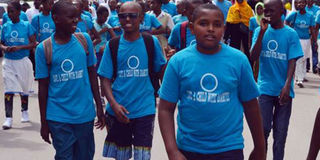We can stop the epidemic of diabetes

Children take part in a Diabetes walk on Nkrumah road in Mombasa on July 25, 2015. If you are already diabetic, taking lowering blood sugar using drugs can prevent the risk of blindness, kidney damage, amputation, or heart disease. PHOTO | KEVIN ODIT | NATION MEDIA GROUP
What you need to know:
- About 1.8 million people in Kenya have diabetes while a further 1.5 million have the disease but have not been diagnosed.
- Globally, someone dies every seven seconds from diabetes, with an estimated five million deaths attributable to the disease in 2014 alone.
As the world marked the World Diabetes Day on November 14, it got me thinking about my dear maternal aunt, Rhoda Ochieng’, who died eight years ago after struggling with type 2 diabetes and high blood pressure for over a decade.
Until recently, it puzzled me that her lifestyle did not strike me as that of a person who could contract the disease.
She lived in the rural areas all her life and went to the shamba every morning, meaning she lived a relatively active life, unlike yours truly who has an eight-to-five job that involves, first sitting in the car for hours and then at the office desk reading emails the entire day.
Her diet mainly consisted of brown ugali, fish, vegetables, and tea with milk and sugar.
Like other people in rural areas, white bread, chapati, or rice were reserved for special occasions.
She also never smoked cigarettes all her life or took alcohol. I will soon explain why I think my aunt became diabetic.
About 1.8 million people in Kenya have diabetes while a further 1.5 million have the disease but have not been diagnosed.
The reasons for this are multifactorial and include transition to an increasingly urbanised, sedentary society resulting in increasing obesity, as well as early life influences such as maternal nutrition and overfeeding newborn babies.
Globally, someone dies every seven seconds from diabetes, with an estimated five million deaths attributable to the disease in 2014 alone.
RISK ASSESSMENT
And 77 per cent of people with diabetes live in low and middle-income countries.
Globally, there are 400 million people with type 2 diabetes and the disease costs the world economy about $471 billion (Sh48 trillion).
To understand why my aunt got diabetes, you need to fill out a simple self-administered questionnaire that looks at eight risk factors for developing the disease.
These include a person’s age, body mass index, waist size, physical activity levels, frequency of consuming fruits and vegetables, use of antihypertensive medications, history of high blood glucose (diabetes in pregnancy or birth to a baby weighing above 4.1 kilos), and family history of type 1 or 2 diabetes.
Points are given depending on the answers provided and having several of these factors together means your risk of getting diabetes in the next 10 years is increased.
For example, a score lower than seven indicates very low risk while a score of more than 20 indicates a one-in-two chance (50 per cent) of developing diabetes.
This means that in a crowd of 100 people with the same risk profile as you, 50 are likely to develop diabetes in the next 10 years.
Looking back at my aunt’s profile, her age (score two), high BMI (score three) and waist size (score four) and the fact that she had high blood pressure (score two) were already red flags.
From her medical records, her BMI was above 30 per cent, way above the limit of 25 that is considered normal (BMI is a person’s weight in kilogrammes divided by the square of their height in metres).
I also came to learn that her own father (my grandfather), a tall well-built veteran of the Second World War, was also diabetic (score five).
I now know that all these factors contributed to my aunt’s elevated risk of 16 points, meaning, at some point in her life, she had a one-in-three chance (33 per cent) of developing the disease.
TAKE ACTION
Some good news: although the epidemic of type 2 diabetes (the commonest type that affects over 90 per cent of people) is unstoppable, it can be prevented or even reversed with simple lifestyle changes such as being more physically active, eating a healthy diet, and losing weight.
If you fill out this questionnaire and find that your risk is above 12, all is not lost.
Although you cannot change something like your age or genetic lineage (just because my aunt was diabetic, I start out with a score of three) there are things you can do to prevent and reverse your lifetime risk such as reducing body weight, exercising daily, and ensuring that you eat enough portions of fruits and vegetables daily.
In fact, if you are in the early stages of diabetes (pre-diabetes is blood sugar between 5.7 and 6.4 per cent using a test called A1C) losing between five and 10 per cent of your body weight prevents diabetes from developing.
If you are already diabetic, taking lowering blood sugar using drugs can prevent the risk of blindness, kidney damage, amputation, or heart disease.
Dr Obwogo is a senior quality improvement advisor in health policy and systems strengthening. [email protected]





